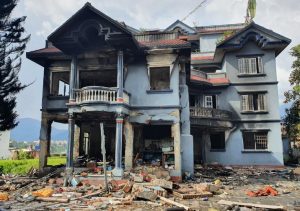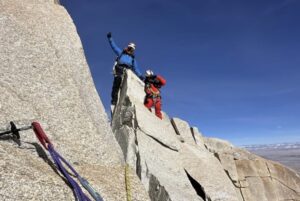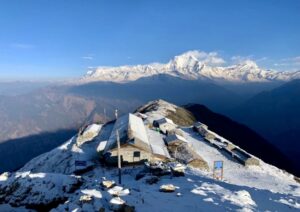As if Nepal’s new prohibition on trekking independently was not enough, recent news about roads invading the Annapurna trekking trails has dealt potential trekkers another reason to shop elsewhere.
However, the issue is not new nor as simple as it first seems.
Walking by the roadside
According to The Himalayan Times, the Annapurna Circuit is evolving into an unpleasant roadside walk, amid clouds of dust from passing motorcycles, 4x4s, and buses.
Local entrepreneurs complain that most tourists are shortening their visits or picking different destinations.
“No substantive efforts have been made so far to protect the trekking routes,” villagers told the paper.
However, there are some nuances. First, most of the roads are dirt tracks. Many have little traffic. Some look just like a wide walking trail.

Photo: Roland Hunter
Second, roads improve access to schools, doctors, and supplies for the local communities. One of the features of Nepal treks, especially the Annapurna region, is that it is not pure wilderness. Thousands of villagers live along the route, and a trek is as much of a cultural experience as a scenic one. Many Nepalis live hard lives and welcome the improvements that roads bring.
Not just Annapurna
“It’s fair to say that there have been significant changes along the trekking routes over the past decade,” the Travel & Trek agency writes on its website about these busier pathways. “But new trails, away from the dirt tracks, have also been developed to reinstate the status quo.”
“The creeping roads in Nepal are affecting many treks, and we updated quite a few itineraries, such as Manaslu Circuit and Kanch Circuit,” Roland Hunter of The Mountain Company told ExplorersWeb. Hunter, also an Everest and Makalu summiter, noted that the changes have been particularly striking two years after COVID. Development continues in several hill and mountain areas.
The problem occurs when popular trekking trails are enlarged into roads. This happened on the road to Manang along the Annapurna Circuit. Here, what brings convenience for locals affects the region’s vital tourism economy.
“The reality in Nepal is that there is a lack of planning, so villages often build roads in national parks without official permission,” Hunter explained.
The current state of the Annapurna Circuit
The hyper-popular Annapurna Circuit, one of the longest in Nepal, opened to foreign trekkers in 1977. Originally, it took 23 days through an ever-changing landscape. You could experience the rainforest beside the deepest gorge on Earth (the Kali Gandaki), the peaks of the Annapurna massif and Macchapuchare, and the higher pastures near the Tibetan border or the Thorng La pass at 5,316m. Check a map of the classic circuit here.

Google Maps shows how to get from Manang to Muktinath by car. It is not a fast trip (average 24kph), but doable.
Road construction started in the 1980s. It proceeded slowly at first, then sped up during the oughts.
“The road has been operating since around 2008,” Hunter said. “Over the years, it has been widened and made easier for Jeeps and less likely for landslides to block it during the monsoon.
“Nowadays, the road extends from the town of Besisahar up to Manang village. This is only a three-day trek to Thorong La. On the other side of the pass, the road goes all the way up from Beni to Muktinath village.”
As a result, the 23-day trek can dwindle to a few days on the highest terrain – something you don’t want to do without first acclimatizing. Or it requires days of walking along a dusty road.

Campbell and Alya Lous at Thorong La pass. Photo: Stingynomads blog
Trekkers Alya and Campbell Louw of South Africa have written a complete guide to the Annapurna Circuit on their blog Stingynomads. Here, they address the issue and offer details on how many kilometers one must walk along the roads, which have more traffic, and how to avoid at least part of those sections. Here is a summary:

The Louws have divided the Annapurna Circuit into four parts, noting which sections of road have vehicles passing every 15 minutes or so. Chart: Campbell Louw
The Louws note that few people still do the entire 260km full circuit from Bhulbule to Nayapul. Nowadays, the standard route starts in Jagat and finishes 136km later in Jomsom.
Alternative trails for pedestrians
The Annapurna Circuit has several variations, including detours away from the road.
Called the Natural Annapurna Trekking Trails (NATT), it has been under development since 2010. Villagers used this network of trails for many generations, and now they have been repurposed for trekkers. The two forces behind this initiative are Prem Rai, a Nepali hiking guide, and keen trekker Andrees de Ruiter.
The NATT routes are marked with red-and-white and blue-and-white stripes. However, comments on travel forums show varied opinions, including criticisms that some trails lie just meters away from the dirt road or have been bulldozed.

The Natural Annapurna Trekking Trails (NATT) are marked with either red-and-white or blue-and-white stripes. Photo: Actual Adventure
“NATT has been fundamental to the renaissance of Annapurna Circuit, and has become the default Annapurna Circuit trail,” says Roland Hunter. “For example, one of the best NATT trails is the high route from Upper Pisang to Manang. The views of the Annapurnas are incredible, and the trail avoids the road in the valley below.”
Hunter also noted that his agency usually ends its treks at Jomson, since the NATTs below that town are not so good.
In any case, those who trekked this area 20 years ago will see that things have changed.
In a piece published in 2018, Onlinekhabar — a Nepalese news portal — admitted that the Annapurna Circuit was no longer among the country’s best treks. And some local farms are closing because of cheaper competition from elsewhere.
“[Now] everything comes from below and as they get things for cheap, no one bought chickens from me,” a farmer from Pisang told Onlinekhabar. He had to shutter his poultry farm.
Is the classic Annapurna Circuit still worth doing? Alya and Campbell Louw of Stingynomads grudgingly believe so. “The scenery is spectacular,” they wrote. “The road did spoil some parts of the trek but definitely didn’t ruin it entirely.”

Photo: Roland Hunter
Other regions
Cars have not yet reached the Khumbu, although a road toward Lukla is under construction. The constant sound of helicopters, however, also distracts from the scenery.
“For Manaslu, the feedback from our groups in autumn 2022 is that…it would be better to drive one day’s trek further up the valley to Macha Khola,” Roland Hunter says. They also start driving one day earlier at the end of the trek, from Dharapani.
“For the Kangchenjunga region, we are using the road to drive out three trekking days earlier than before,” Hunter added. “Also there is hydropower construction going on near Sekathum.”
There still do exist remote treks, where roads continue to have little impact, such as the Great Himalaya Trail, which runs east-west. Most of the roads follow valleys oriented north-south.

Roland Hunter on the summit of Makalu summit in 2009. Photo: Screenshot/YouTube
But Nepal is changing fast. “As long as groups know about this beforehand, they have the right expectations and can still enjoy these treks,” Hunter concludes.






